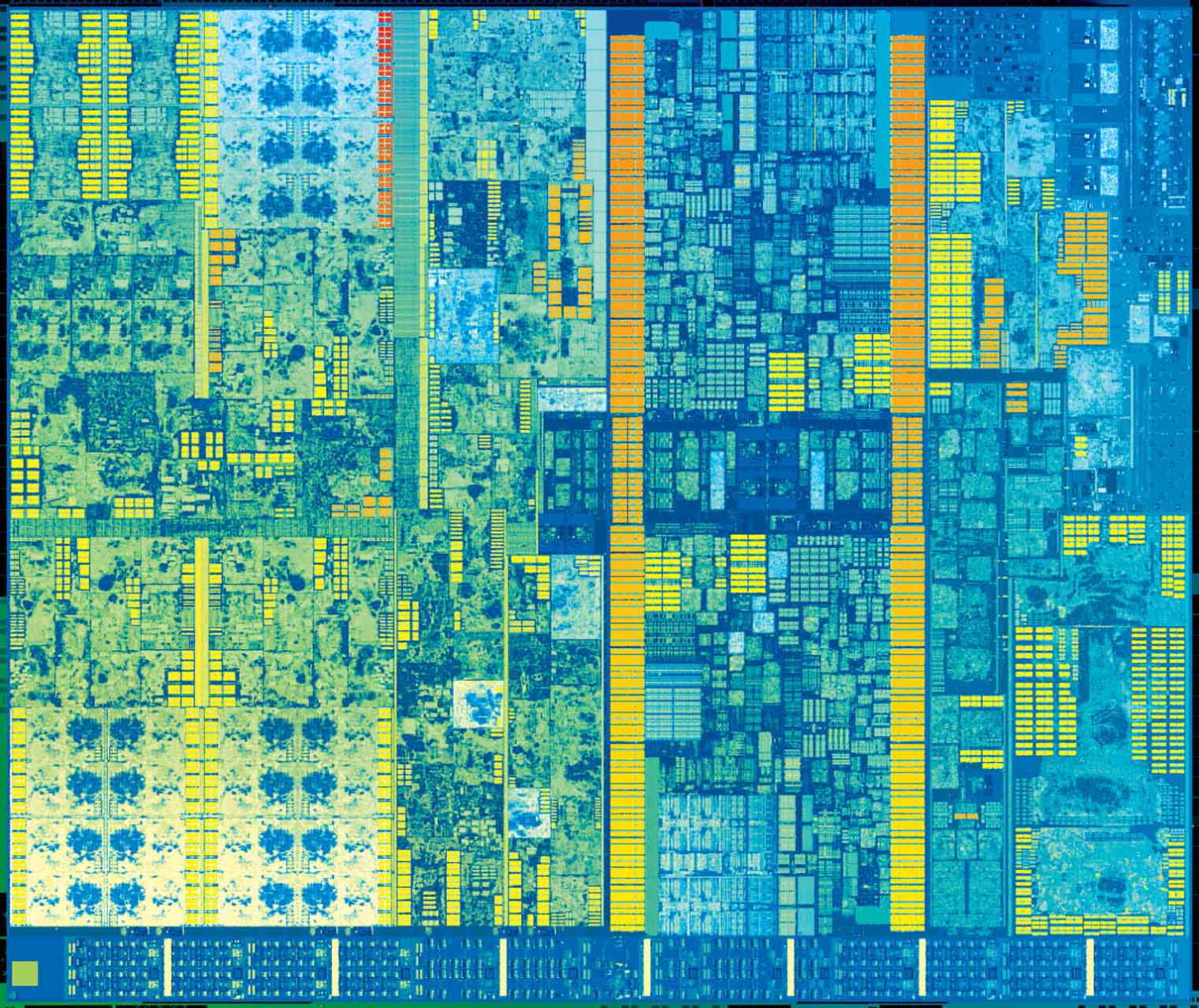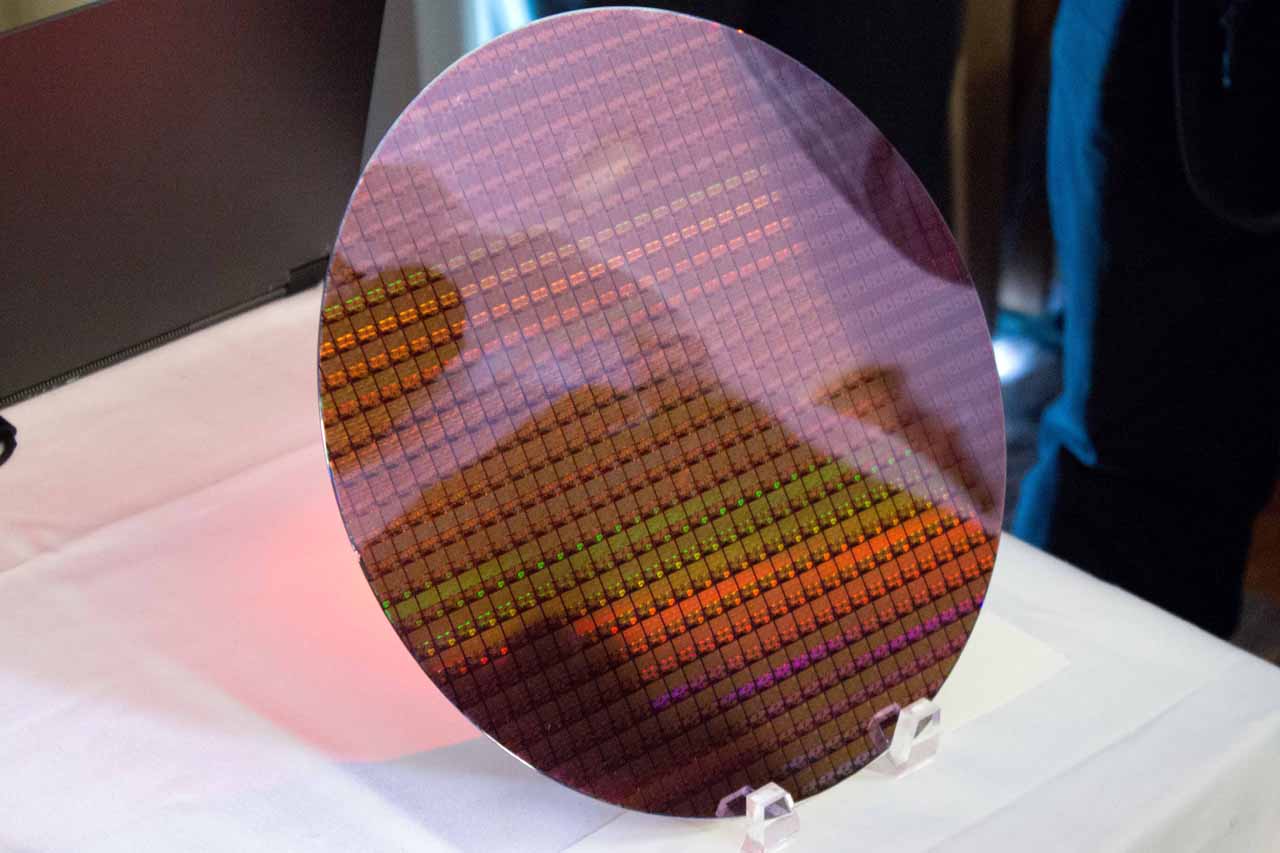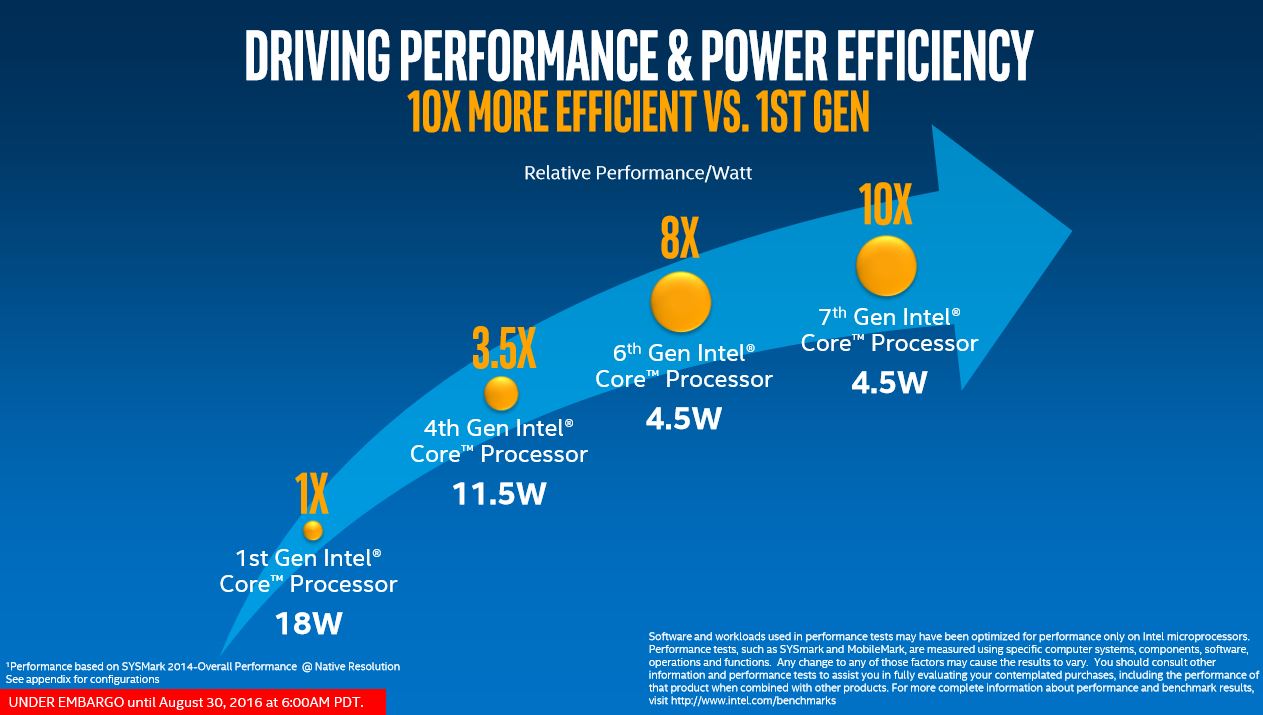Intel Kaby Lake: 14nm+, Higher Clocks, New Media Engine
Introduction
The first wave of processors based on Intel's seventh-gen Core architecture (more commonly referred to as Kaby Lake), featuring the company's optimized 14nm+ process, will ship in systems this coming September. They'll make their debut in over 100 OEM designs geared for the 4.5W (Y-series) and 15W (U-series) segments, addressing a range of mobility-centric applications like 2-in-1s and thin/light notebooks.
The new cores feature higher clock rates and more aggressive Turbo Boost frequencies. Intel is also making a number of improvements to its media engine.
The Kaby Lake generation signifies the end of Intel's tick-tock cadence. The company remains committed to delivering new designs every year, but the challenges and economics of Moore's law spurred Intel's transition to the process-architecture-optimize strategy (PAO). Intel has already stretched its traditional two-year cycle: it brought us 32nm in 2009 and 22nm in 2011, but the transition to 14nm arrived in late 2014. The switch to 14nm already hinted at a longer period between each new architecture and process shrink, so Intel's disclosure of the new PAO scheme merely confirmed our suspicions that Moore's Law was winding down.
We're now seeing Intel's third design based on a 14nm process (Broadwell/Skylake/Kaby Lake), and the optimization phase involves fine-tuning Skylake's core architecture. The design's basics, such as its instruction pipeline (fetch, decode, execute), remain unchanged. This means that IPC (instructions per cycle) throughput should stay consistent. However, Intel claims that its improved 14nm+ transistors and interconnects (more on that later) are 12% faster than the previous-generation process, driving a clock rate increase of up to 300-400 MHz compared to Skylake.
Intel also worked to increase the performance of key components inside its media engine. The company claims these enhancements deliver substantial improvements in a majority of common use cases in the mobility space, which is the high-growth target segment for its latest processors.
Seventh-Gen Core (Kaby Lake)
The desktop PC refresh cycle is lengthening from 3-4 years to 5-6 years. But while the mainstream PC segment is contracting (Intel noted the majority of PCs are five years or older), the enthusiast space is experiencing a healthy growth trend. Last year, unlocked K-series SKUs grew 20% year-over-year for desktop and notebook PCs.
The 2-in-1 segment is an even bigger catalyst for growth because it features faster upgrade cycles (by roughly eight months). This fueled a 40% increase in the number of 2-in-1s sold last year. Intel projects that the 2-in-1 segment will continue to expand "in the double digits" next year. There are already more than 100 Skylake-based 2-in-1 designs on the market, ranging from low-power to high-performance solutions, and Intel expects Kaby Lake's entrance to increase the range of options.
Get Tom's Hardware's best news and in-depth reviews, straight to your inbox.
The ultra-thin and light notebook category is also growing quickly, and Intel notes that the sales of Chromebooks are outpacing tablets in some key areas. The mini PC segment, including NUCs, grew by 60% last year alone, in part because lowered TDPs allow vendors to pack more compute into a smaller space.
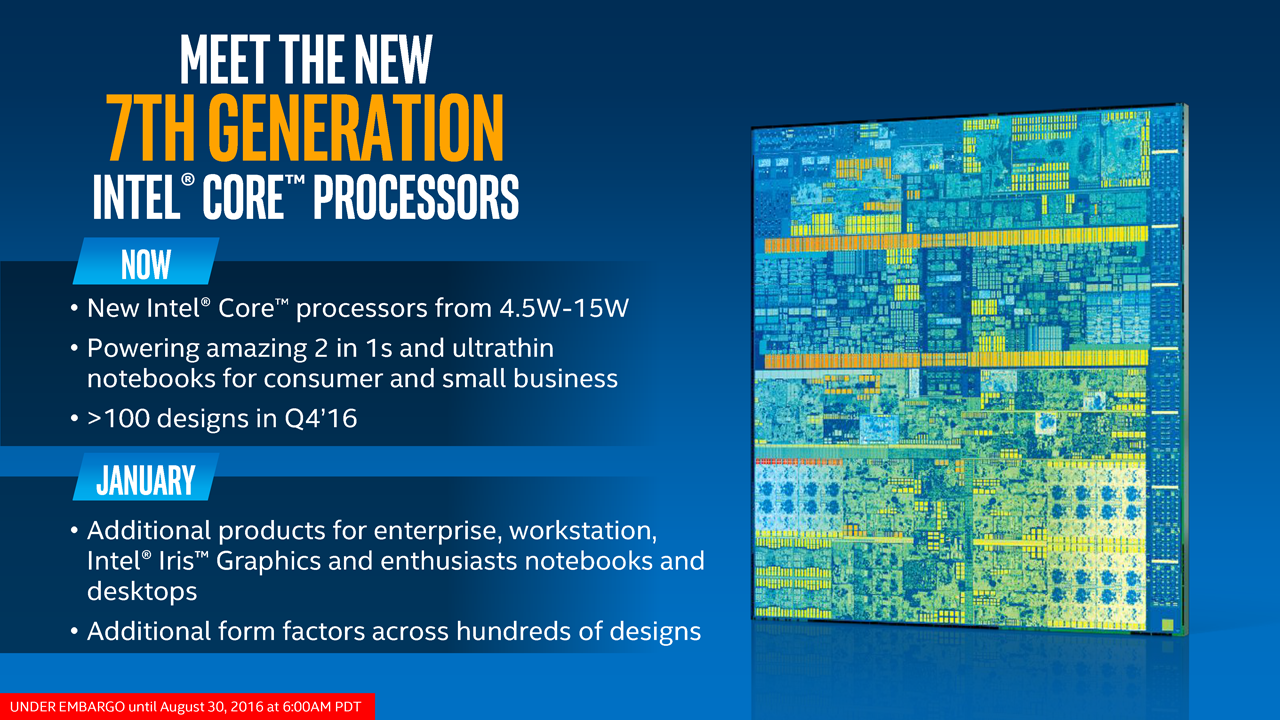
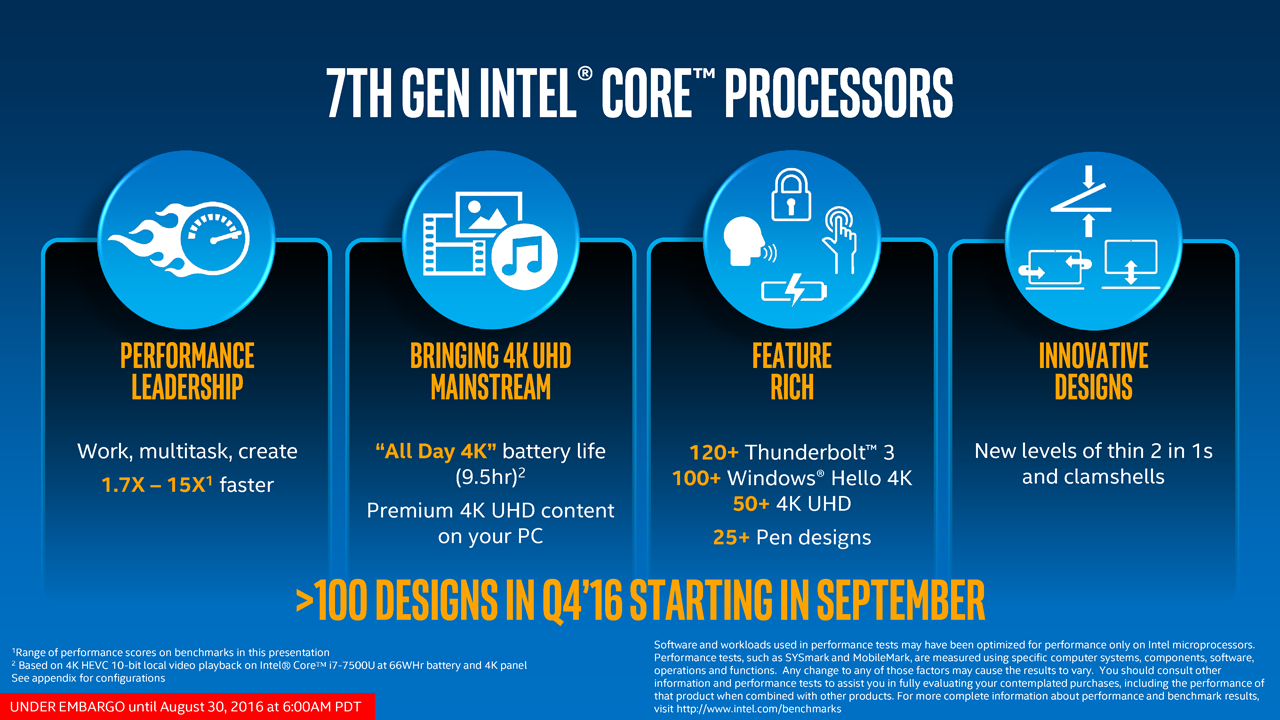
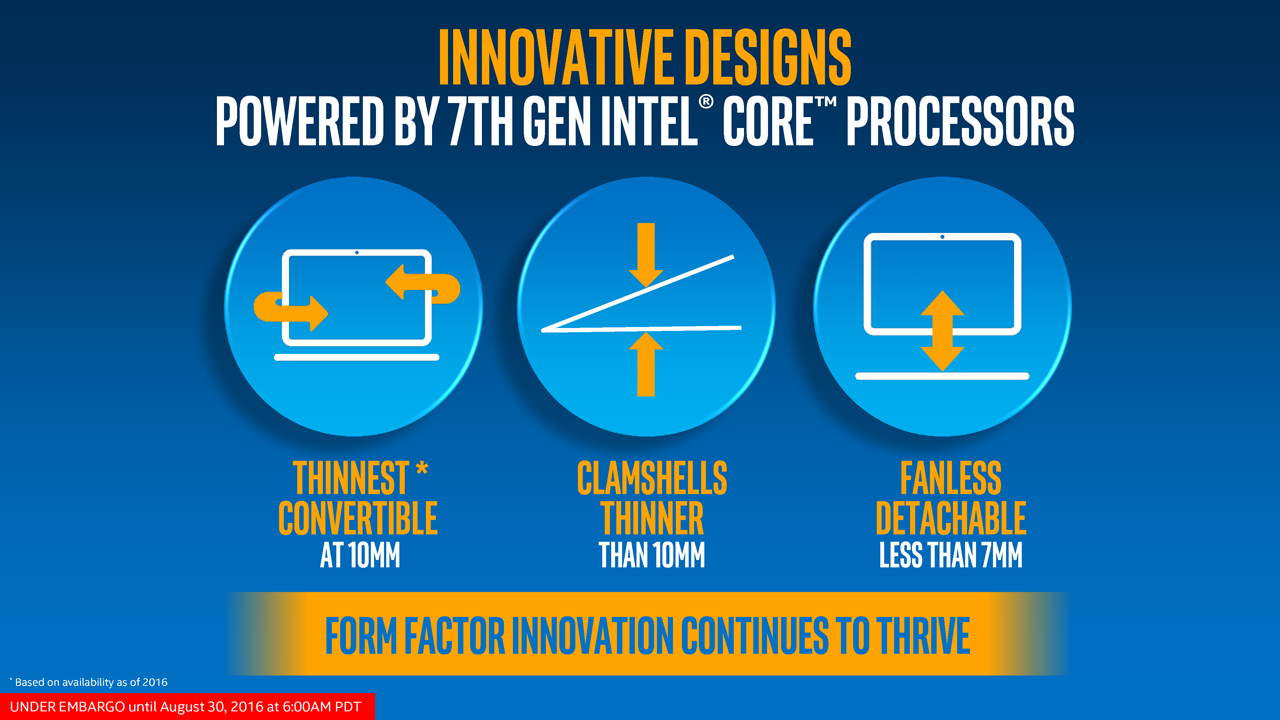
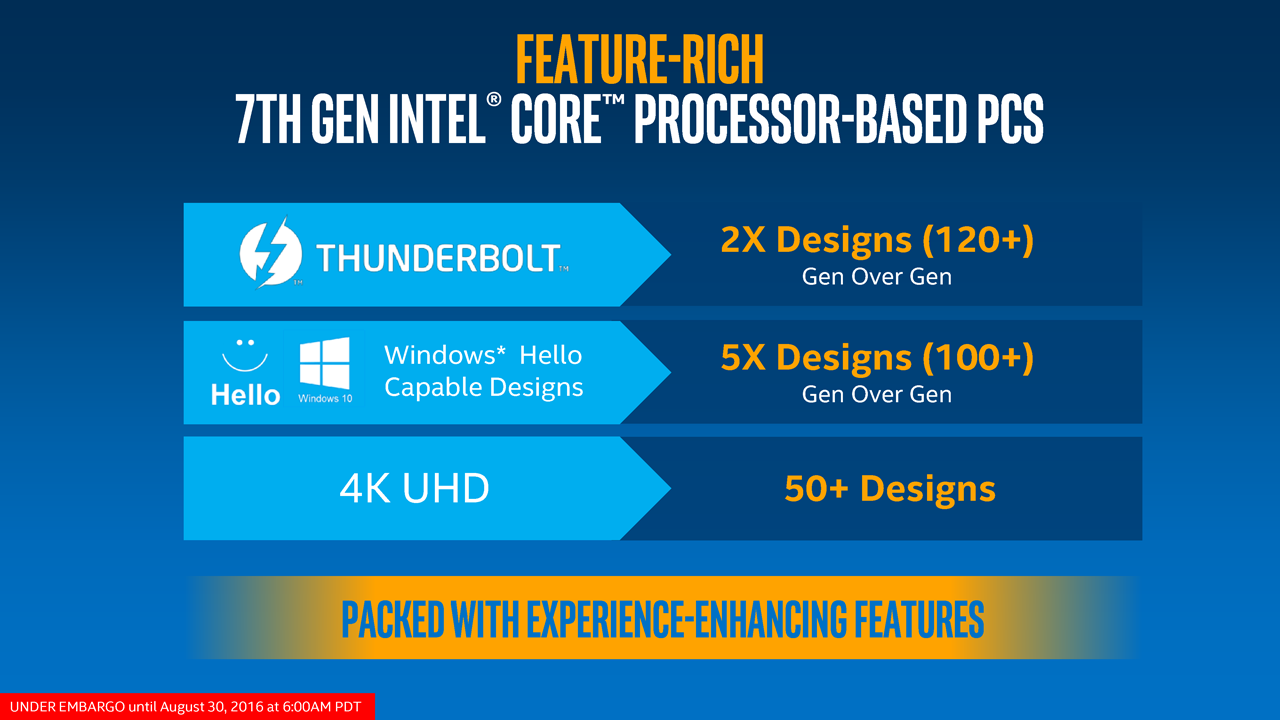
The Y-series and U-series processors target the majority of high-growth segments, and Intel predicts that more than 100 Kaby Lake designs will launch by the end of this year. From a high level, the company claims these processors are 1.7x to 15x faster in various workloads. It also notes that significant advancements in the media processing architecture boost battery life during 4K playback.
Intel has ambitious goals. It's expecting an additional 350 designs to come to market in the first half of next year. The 2-in-1 and ultra-light devices are the stomping grounds of new features, such as touch, stylus, and IR cameras for face scanning, and other bio-metric sensors. Intel indicated there would be more than 120 Kaby Lake devices with Thunderbolt 3, providing up to 40 Gb/s transfer speeds and up to 100W for system charging. Intel projects that more than 100 designs featuring Windows Hello (bio-metric sign-in) will come to market, as well as more than 50 designs that support UHD and more than 25 designs equipped with pens.
The slimmest convertible designs will feature a 10mm thickness, while some clamshells should be even thinner. For those on the hunt for the ultimate in compact dimensions, some fanless detachable models will go below 7mm.
Kaby Lake-based processors will scale to address a number of segments, but the faster H-series products, which Intel designed for more enthusiast-oriented mobile platforms (like gaming laptops), the S-series (mainstream desktop), HEDT, workstation, and enterprise products are not due until next year.
Intel continues to focus on power efficiency. The company notes that the lowest power ceiling for the first-gen Core architecture (2010) was 18W, but it lowered this figure to 4.5W with the lowest-power Skylake configuration; the company maintains the same number with Kaby Lake. However, Intel says it's increasing Kaby Lake's performance-per-watt efficiency ceiling by 2x over Skylake, which adds up to a cumulative 10x efficiency jump compared to the first-gen products.
MORE: Best CPUs
MORE: Intel & AMD Processor Hierarchy
MORE: All CPU Content

Paul Alcorn is the Editor-in-Chief for Tom's Hardware US. He also writes news and reviews on CPUs, storage, and enterprise hardware.
-
ComputerSecurityGuy Yup, Skylake Refresh. Higher clocks. Slightly lower power consumption. Probably saw a demo of Overwatch on Iris Pro 680 (580 with 200mHz or so higher clocks. Overall, probably not a very interesting release. The only hopeful thing is they might bring Iris/Iris Pro to lower end or lower power SKUs.Reply -
80-watt Hamster Sheesh, why all the negativity? As someone who put together a Skylake platform with an i3, I'm looking forward to more capable -K processors being released for the same socket.Reply -
txhorn Kaby Lake's hardware encode and decode of 4k codecs is significantly better than Skylake. VP9 4k decode is down to 10-20% cpu usage from 70-80% usage. That's pretty awesome for HTPC's and high-res portable battery life.Reply -
AndrewJacksonZA Typo on page two: "Intel is optimizing its transistors by improving their fin profile with taller fins and a wider gate pitch" That should be a NARROWER gate pitch.Reply -
goblinissimus Nothing about USB 3.1 Gen 2, TB3, DP1.3, HDMI 2.0b/HDCP 2.2?Reply
Also, 12 bit (aka Dolby Vision or DV) HEVC decode would have been nice. -
digitalgriffin You know intel keeps bragging about how you get more battery life. Yet manufacturers keep shrinking the Wh on the batteries and intel keeps raising their prices. You really gain nothing in terms of battery life or cost.Reply -
80-watt Hamster Reply18520394 said:$389 for a 2 core 4 thread processor....thanks but no thanks.
4C8T perhaps you mean? I can't see Intel trying to charge nearly $400 for an i3.
